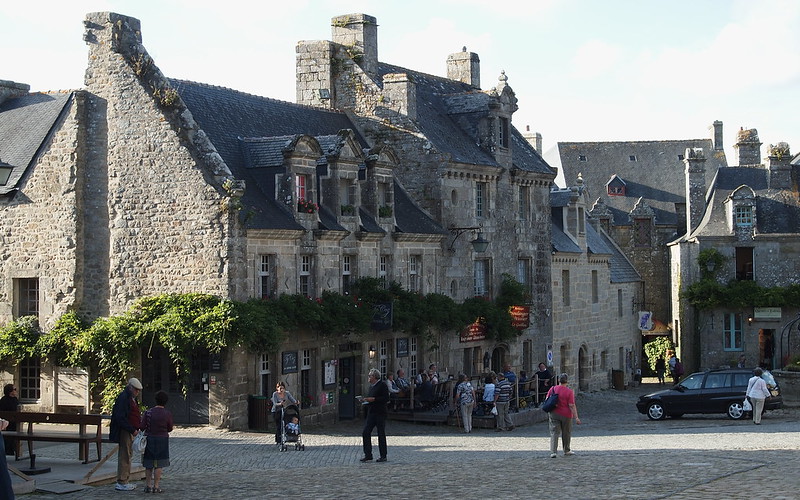On the Road in Brittany
Each year when I travel to France, I have a theme. Last year, it was Provence, and the year before, I went to Alsace. (And Paris is always in there too.) This year… it’s Brittany in northwest France. Brittany touches the English Channel to the north and Normandy to the east. Green hills, rocky coasts, and Celtic towns await my travel companion and me. Some places on the itinerary are new to me, like Vannes, Fougères, and Vitré, which all seem like medieval fairytale towns, each with its château and centuries-long history.

Dinard
A few years ago, I wrote a book called Hit the Road in France: 9 Road Trip Itineraries Across France. The book contains complete road trip itineraries travelers can use as-is or build upon for their own road trip adventure.
When I plan my trips, I often use one of the road trips in that book. My objective is to expand on each trip, since there’s always more to see and discover each time, all so I can offer more value to readers in subsequent updates.
I’ll research every town, maybe add a couple of new ones, and update information on great activities, tips, and new impressions of each town. I’ll also take lots of photos and videos. I plan to share those with you on Oliver’s France in future posts and Instagram while I’m on the road. So, stay tuned to your Oliver’s France IG posts.
Just like in the road trip in the book, I’ll begin in Rennes, the largest city in Brittany. It’s a relatively short train ride from Paris. The Museum of Brittany there will provide a great overview of the history and current cultural treasures all over the Brittany peninsula.
So, What’s the Story with Brittany?
People have lived in Brittany for 35,000 years! Are there signs of that early residence? Not many, but you can still see standing stones in and near the town of Carnac in Western Brittany. These stones are similar to Stonehenge and date back to around 3000 BC.

Fougères
Brittany was originally inhabited by the Celts, then the Romans. You can still see Celtic influence in the language, food, and customs. Following the expulsion of the Vikings in the 10th century, Brittany became a Duchy, run by independent dukes. There were still wars and struggles, including with the English and the Hundred Years War.
In the 16th century, Brittany was still not a part of France. Francis II was then the Duke of Brittany and his young daughter was Anne. Though she was only fourteen, she was married by proxy to Maximilian I, who was the Holy Roman Emperor. Charles VIII of France would have none of it, and after attacking Rennes, had the marriage cancelled. He wanted to marry Anne himself.
Before you swoon at the romantic account of Charles fighting for his beloved, know that Charles’ motivation was obtaining Brittany. Anne was his key to doing that (and apparently, neither one was too happy about the arrangement.)
So, in 1532, Brittany became part of France, thanks to the begrudging wedding of Anne, who married Charles in the Chateau of Langeais in the Loire Valley a few years earlier then settled mostly in Amboise. She tried to preserve Brittany’s independence but didn’t succeed. After Charles’ death, she married his cousin and as a result, was the only woman to be queen of France twice (to two separate kings.) Much of their story was played out in The Loire Valley.
So, quite a dramatic backdrop to this long-disputed area of France!

Locronan, Western Brittany
Brittany Today

A Savory Crepe
Today, Brittany’s strengths, aside from pastoral beauty everywhere, lie in seafood, agriculture, and tourism. It’s especially popular among Parisians and Brits for a weekend visit or a second home.
It’s a stunning green region where the rainfall is a bit higher than elsewhere in the country. Many of its natives identify strongly as Breton as well as French, which makes this area different from elsewhere in France.
Like other regions of France, Brittany has its own cuisine specialties. Crêpes come from this region and are usually eaten alongside a bowl of cidre, an apple beverage that resembles sweet beer more than apple cider. Along with that is seafood, since Brittany has two coastlines, and other specialties. Worth noting are the desserts… Far Breton, Kouign Amann, Gallette Bretonne, and more. I’ll fill you in on those treats with facts and photos (as I’m filling myself with them!)
Stay tuned for more on this amazing region. We’ll discover it together!
Related Posts
Brittany Charm: 8 Towns You Must See
St Malo: A Treasure on the Coast of Brittany





